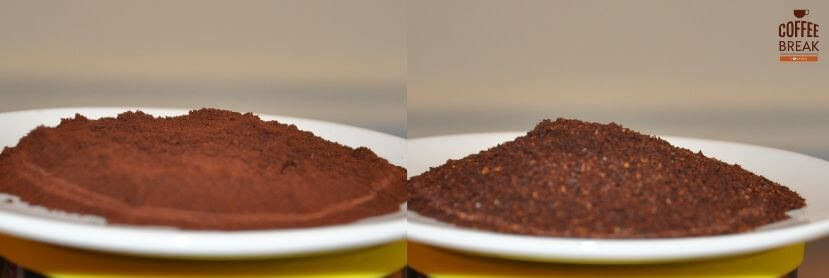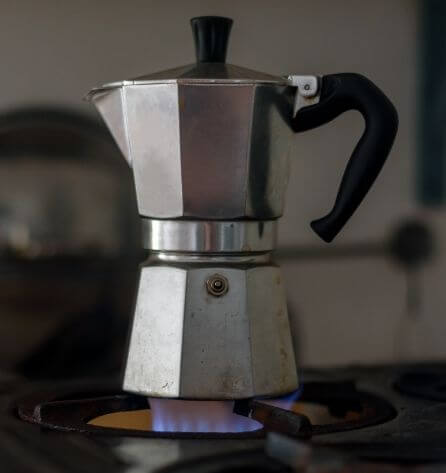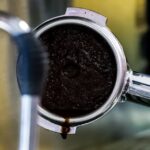Moka Pots are popular for brewing strong, espresso-like coffee. But if you’re not careful, you could end up with sediment and sludge in your coffee!
This doesn’t have to be the case though! With just a few changes you can get a smooth cup of coffee from your Moka Pot.
We’ve got 9 simple fixes you can try, but like most things, each one has pros and cons.
Take a look at each of these solutions and see how to reduce sediment in moka pot coffee!
1. Use Larger Grinds To Reduce Coffee Sludge
If you have sediment in your coffee, it’s most likely because your beans are ground too small.
The best grind size for Moka Pot coffee is generally medium to fine. But if your grinds are a little too fine, they can flow right through the filter gasket and become sediment in your brewed coffee.

The solution here is to grind your coffee grinds slightly larger than you normally would. This will ensure that the grinds are too big to slip past the gasket.
But keep in mind the larger the grind, the less flavor is extracted. So, when you reduce the sediment, you’re also reducing flavor.
2. Avoid Pre-Ground Coffees To Prevent Sediment
It’s common for Moka Pot owners to buy pre-ground coffee. However, you could end up with sediment in your coffee depending on the brand you buy.
For example, Cuban coffee beans are made specifically for the Moka Pot and they’re usually ground very finely – this is part of what makes Cuban coffees so robust.
But because the grinds are so fine, these can also pass through the filter and become sediment in your coffee.
If this is happening, consider buying whole beans and grinding them yourself or buying ground beans that are coarser.
3. Place An AeroPress Filter In Your Moka Pot
A fool-proof method to remove sediment from your coffee is to place an AeroPress filter between the filter and your ground coffee beans. (If you don’t any, you can check out AeroPress filters on Amazon.)
But say you don’t have an AeroPress coffee maker and you don’t want to buy the filters just for your Moka Pot.
In that case, you can buy paper filters for a drip coffee machine (like these filters here) and cut them so they fit your Moka Pot.

A paper filter will prevent any sediment or sludge from getting into your coffee regardless of how fine your grinds are.
However, it will also prevent a lot of the oils from getting into your coffee as well.
So, your final cup won’t be nearly as robust when you use the paper filter.
Shop For Related Products
4. Minimize Sediment By Using A Burr Grinder
By choosing a less fine grind, you can minimize sediment in your coffee. However, using a burr grinder instead of a blade grinder can reduce sediment even further.
Blade grinders will chop your beans up in a random manner, so there’s no way you’re going to get grind uniformity.
Some pieces will be large and coarse, others will be fine and powdery. And it’s these fine, powdery pieces that will pass through the Moka Pot filter to become sediment in your coffee.
However, burr grinders crush the beans in a more controlled manner and the grind size is more uniform. This means you won’t have as many powdery grinds and less sediment.
If you don’t have a burr grinder, there are automatic versions like the Cuisinart Automatic Burr Mill and manual versions like the JavaPresse Conical Burr Grinder.
Related Posts:
- Should You Use Hot Or Cold Water In A Moka Pot?
- Should You tamp A Moka Pot? Here’s What You Need To Know!
5. Lower The Heat To Reduce The Brewing Pressure
Part of the reason sediment gets into your Moka Pot coffee is high heat and high pressure.
High heat generates a lot of vapor pressure which forces the water up through the grounds too quickly. As a result, small grinds are pushed upward along with the brewed coffee.
One solution is to lower the heat.
Instead of letting your coffee brew on high heat, turn the heat to medium or medium-low.
By doing this, you’ll lower the vapor pressure in the Moka Pot, and decrease the likelihood of getting sediment in your coffee.
If you’d like to know more about the right temperature for your Moka Pot coffee, we’ve got a whole post on it! Check out “When To Take Moka Pot Off The Heat“.

6. Strain Your Coffee Through A Filter To Remove Sediment
Another option to remove the sediment from your coffee is to filter your coffee again after brewing it.
Since the coffee grinds that slip through your Moka Pot’s filter are fine, you’ll need to get an even smaller filter for this to work properly.
Luckily there are a few options that could work.
Cocktail strainer – Cocktail strainers are specifically made to filter fruit pulp and ice from mixed drinks, but many people also use them for filtering out coffee grinds. One option you can check out is the OXO Steel Cocktail Strainer on Amazon.
Coffee sock – an old-school coffee sock or colador is like a net used to brew coffee. It’s pretty good at straining grinds out of your coffee. Check out these Flannel Cloth Coffee Filters to see if they’ll work for you.
Other filters – there are also other filters that can strain out coffee grinds. For example, the Purelife Coffee Enema Strainer is 10x micro mesh and many people successfully use it to strain grinds from their coffee.
The only downside to coffee strainers is that they could easily reduce the temperature of your coffee if you don’t pre-heat them.
And since your Moka Pot coffee sediment is so fine already, it’s possible some of the grinds still get through the strainer.
Shop For Related Products
7. Make Sure Your Moka Pot Is Clean Before Each Use
If you’ve got sludge in your coffee, it’s possible that it was already in your Moka Pot.
The best way to prevent old grinds from winding up in your coffee is to regularly disassemble your Moka Pot and clean it thoroughly.
Be sure to give special attention to areas where coffee grinds can hide.
For example, grinds could be in the top chamber or inside the spout the coffee comes out of. They could also be trapped behind the filter or under the gasket.
Also, keep in mind that if you’ve got an aluminum Moka Pot, some black discoloration may develop. So what you think is discoloration could actually be old grinds or vice versa.
8. Check That Your Moka Pot Is In Good Shape
A broken filter or gasket could also cause sediment to get in your coffee.
Over time, the rubber gasket that seals the top and bottom halves of your Moka Pot will become worn and cracked. If this happens, some coffee grinds may be able to slip through the cracks and get into the coffee.
A damaged or broken filter could also allow coffee grinds to end up in your final cup of coffee.
To prevent this, it’s recommended that you periodically replace these parts. (You can check out filters and gaskets on Amazon.)
9. Don’t Pour All Of The Coffee From The Moka Pot
Coffee sediment usually enters your cup as you pour the last few drops of coffee.
So, if none of the previous methods have worked for you, one final option is to brew the Moka Pot coffee like normal and wait a few seconds so the sediment can settle to the bottom of the Moka Pot.
Then carefully pour the coffee into your cup while leaving a small amount of coffee (and the sediment) in the Moka Pot.
Cheers Coffee Lovers!

KEEP READING
- What Are The Best Coffees For Moka Pot Brewing?

- Bialetti Brikka vs Moka Express (Which Should I Choose!?)

- Cafe Bustelo vs Pilon (Which One Should You Choose?)

- What Is A Colada Coffee? (A Delicious Cuban Brew!)

- Is Arabica Or Robusta Best For Cold Brew Coffee?

- Why Is My Espresso Puck Wet? (The 6 Most Common Reasons)


Oliver is co-owner of Coffee Break Lovers. The only thing he loves more than the process of brewing coffee is drinking it.

